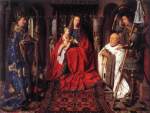Remember to click on the artwork to see it clearly in an enlarged format!

Jan Van Eyk (circa 1390-1441) was a Flemish painter who is considered to be one of the most significant northern European Renaissance painters of the 15th century. He was a member of a famous family of painters believed to have originated in the town of Maaseik, in the diocese of Liège.
The work of the family van Eycks is exemplified by the great Ghent Alterpiece, begun by Hubert van Eyk and finished by his brother Jan. This particular painting brought an unprecedented realism to the themes and figures of late medieval art. You may have seen it featured in the recent movie, The Monuments Men, since it was stolen by the Nazis during WW II.


Little is known of his early life, but his emergence as a painter followed his appointment to the court of Phillip the Good, the Duke of Burgundy(1425–41), who was his patron until his death. His work in the court gave him a high social standing which was unusual for a painter, as well as artistic independence from the painters’ guild of Bruges, where he settled. Van Eyck was literate (as shown by his own handwriting) which is why some of his frequent travels for the Duke were diplomatic missions. His practice of signing and dating his pictures (unusual for the time) was a way of promoting himself.

Following his appointment by the Duke of Burgundy, Van Eyck’s reputation and technical ability grew. He became known for his innovative approaches in the handling and manipulating of oil paint. His revolutionary approach to oil was such that some considered he had invented oil painting! Van Eyck used the technique of applying layer after layer of thin translucent glazes to create paintings with intense tone and color. He took advantage of the longer drying time of oil paint to blend colors to achieve subtle variations in light and shade; this heightened the illusion of three-dimensional forms.

Another part of his prestige came from his skill was in pictorial illusionism. The landscape of his Crucifixion is a good example: cracked earth, cloud formations, and perspective. Comments from his contemporaries marvel at his ability to mimic reality and to re-create the effects of light on different surfaces. One of the best examples of these abilities is illustrated by the Virgin of Canon van der Paele (1434–36), from the glinting gold threads in the brocaded blue cape to the glow and dazzle of the faceted jewels to the precise detail of the kneeling Canon, which illustrates his skill as a portraitist. These skills imbue an absolutely still, quiet scene with energy.

Another van Eyk masterpiece is the Arnolfini Protrait or Arnolfini Marriage, an oil painting on oak panel dated 1434. The painting is a small full-length double portrait, believed to represent an Italian merchant named Arnolfini and possibly his wife. The glowing colors show the material wealth and opulence of Arnolfini’s world. It is considered one of the more original and complex paintings in Western art because the unusual geometric orthagonal perspective (ability to portray three dimensions on a flat surface) and the use of the mirror to reflect the space.
Van Eyck employed workshop assistants to make exact copies and variations of his completed paintings. These helped to supply the demand for his work on the open market and contributed to the recognition of his name throughout Europe, especially after his death in June 1441.
![]()

Beautiful. I don’t know if I can pick a favorite from the above, but Arnolfini Protrait or Arnolfini Marriage I at least recognize. Virgin of Canon van der Paele is also an especially lovely painting.
Thanks again!
Every piece of art above is gorgeous. What a talent! Thanks sharing for this, Noelle.
Sorry I’m not dropping in daily, but I’ll be able to come and feast on your words when it’s all done.
Meanwhile, here’s to Van Eyck! C(_)
Jemima
#TeamDamyanti
Blogging from Alpha to Zulu in April
No problem, Jemima. I’m having trouble finding time to get around, too! Too many riches in too short a time!
I want to learn more now about Van Eyk. I’ve always wondered how he go such depth into his paintings. Thank you!
The View from the Top of the Ladder
The use of light and perspective to create that three dimensional effect was an amazing step forward in the evolution of painting. It was great to read about such an innovative painter. 🙂
I absolutely love van Eycks’ work. I didn’t know the story behind Ghent Alterpiece until I read Monument’s Men. I learned a lot more about van Eycks through this post as well.
Great stuff here. I always get Van Eyk and Van Dyke tumbled together, not to mention Vermeer. Very cool stuff.
Too bad Vermeer wasn’t a Renaissance artist – I really wanted to write about him.